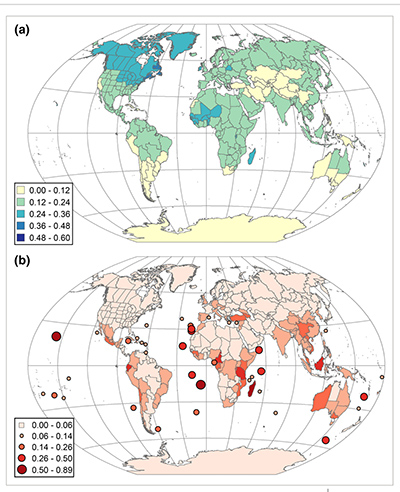Native Plant Conservation Campaign News: State of World’s Plants and Fungi Report - mostly bad news but some progress and plans to move forward
October 13, 2020
THE ELECTION IS LESS THAN 1 MONTH AWAY - VOTE SECURELY AND WITH CONFIDENCE !
The Royal Botanic Gardens, Kew has released a new Report that shows that the world’s plant species are more imperiled than ever.

The State of worlds plants and fungi 2020, based on research from more than 200 scientists in 42 countries, found that 2 in 5 (40%) of the planets plants are at risk of extinction. Previous assessments in 2016 had found that 1 in 5 (20%) of plants were at risk.
Food and Medicine Supply Threatened
These losses endanger humanity. For example, billions of people rely on herbal medicines as their primary source of healthcare. The Report found 723 plants used for medicine are at risk of extinction, with over-harvesting a problem in some parts of the world, including the U.S. Further, “[o]nly 7% of [known] plants have [been tested for use] as medicines. Therefore the world’s plants and fungi remain largely untapped as potential sources of new [cures for disease],” said Melanie-Jayne Howes, a research leader at RBG Kew told the Guardian. “So it is absolutely critical that we better protect biodiversity so we are better prepared for emerging challenges to our planet and our health.”
The same is true for food. Although just 15 plants provide 90% of all calories consumed by humans, there are actually over 7,000 edible plant species that could be used to secure the food supply against climate change, pests and disease.
As Mass Extinction Accelerates, Scientific Community Steps Up
Scientists say plant extinction is occurring up to 500 times faster than what would be expected naturally. A 2019 United Nations report found that up to 1 million plant and animal species are at risk of extinction. The UN revealed in September that the world’s governments have failed to meet any of the 20 targets to stem biodiversity losses that had been agreed to in Aichi Japan in 2010.
“We are living in an age of extinction”, Director of Science at Kew, Alexandre Antonelli told the BBC. "It's a very worrying picture of risk and urgent need for action," he said. "We're losing the race against time because species are disappearing faster than we can find them. Many of them could hold important clues for solving some of the most pressing challenges of medicine and even perhaps of the emerging and current pandemics we are seeing today."
 The assessment also contained some good news. More than 4,000 species of plants and fungi were discovered in 2019. These included wild relatives of important food crops such as garlic, onions, spinach and two relatives of cassava, which could help “future-proof” the staple crop eaten by 800 million people. Wild relatives of medicinal species were found. Kew also reported that the he number of assessed plant species has doubled in recent years due to the Global Strategy for Plant Conservation.
The assessment also contained some good news. More than 4,000 species of plants and fungi were discovered in 2019. These included wild relatives of important food crops such as garlic, onions, spinach and two relatives of cassava, which could help “future-proof” the staple crop eaten by 800 million people. Wild relatives of medicinal species were found. Kew also reported that the he number of assessed plant species has doubled in recent years due to the Global Strategy for Plant Conservation.Urban Green Spaces – More Green Spaces, More Diversity Needed
In additions to sections on medicinal and food plants, and on gaps and progress in plant science, the Report also contained a chapter focused on building resilient urban green spaces to provide ecosystem services in cities. The report notes the growing movement to plant trees and other locally appropriate native plants in gardens, roadsides and urban public spaces. City trees deliver valuable services, from clean air and water to flood protection. Ensuring they can withstand climate change, pests and diseases in the future requires the use of a wide range of species and the support of the pollinators and soil organisms they depend upon.
Greater diversity is badly needed in urban green spaces. Of 6,896,687 trees in 67 locations studied for the Report, ten genera made up almost 40%. Acer (maple) is the most widely grown genus, accounting for 20% of city trees. Many urban trees may be poorly suited to deal with climate change, so the Report recommends expanding both the species and genetic diversity of city trees to make urban plant communities more resilient and sustainable.
Read the full report
Figure. Each country colored by (a) the proportion of plant species covered by a global assessment on the International Union for the Conservation of Nature (IUCN) Red List and (b) the proportion of assessed plant species classified as threatened. More information and the original graph available here in the journal Plants, People, Planet.
But, due to COVID-19 and to voter suppression efforts such as defunding the Post Office,
*many elections are being rescheduled,
*voting places moved, and
*rules are changing.
We want to help people stop worrying about how, when and where to vote!
|
Excercise your right to vote and help your friends, family and colleagues VOTE SAFELY AND WITH CONFIDENCE
Click left or here for our Get Out The Wild Vote Toolkit which offers:
Image © Chris Benda, Illinois Native Plant Society
|
